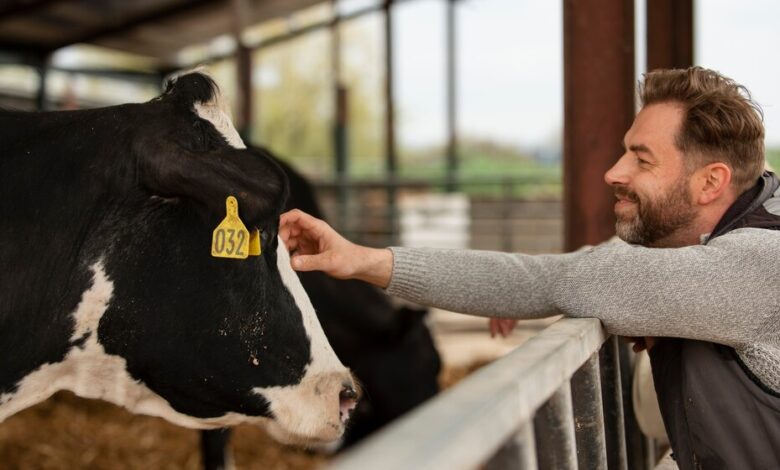Livestock Tagging Rules: All You Want To Know

Tagging guidelines are vital. They govern the identity and control of animals in agriculture. Farm animals ‘ ear tags are among the most unusual methods of cattle identity. These small tags last a long time. They are for animals’ ears. They are for easy identification and tracking. In this guide, we will cover all you want to know. This includes livestock tagging rules and the use of ear tags in animal control.
What are Livestock Ear Tags?
Livestock ear tags are small, flat devices typically made of plastic or steel affixed to animals’ ears. They identify animals. This lets farmers and officials track individual animals in a herd. Ear tags typically incorporate statistics collectively with the animal’s identity range, breed, and, occasionally, the farm or owner’s info.
Why Are Livestock Ear Tags Used?
Livestock ear tags serve numerous crucial functions in animal control:
Identification: Ear tags provide a handy and dependable method of identifying individual animals inside a herd. Farmers can keep accurate statistics of their cattle’s health and breeding history. They do this by giving a unique ID and a wide variety to each animal.
Traceability: In the event of ailment outbreaks or meal protection worries, traceability becomes essential. Ear tags allow the government to hint at a lower return of the beginning region of an animal to its farm or vicinity. This allows for containing and handling the unfolding of illnesses, shielding every animal and human fitness.
Ear tags show ownership. They are key when animals are offered, provided, or traded between farmers or companies. The records are at the ear tag. They help verify the animal’s owner. They stop disputes and enable easy sales.
Types of Livestock Ear Tags
Many kinds of cattle ear tags are available. Each has its unique features and benefits.
Visual ear tags are the most common form of ear tag. They consist of a brightly coloured plastic tag with a printed ID number. These tags have no issues visible from a distance. This makes them good for quickly identifying animals in a herd.
Electronic Ear Tags: These tags are also called RFID tags (Radio Frequency Identification). They contain a small digital chip that stores the animal’s ID records. You can scan these tags with a hand-held reader or constant reader device. They allow quick and accurate identification of animal characters.
The ear tags are tamper-proof. They are designed to deter theft or removal by providing evidence of tampering.
The tags are often metal or strong plastic. They have a lock that stops them from being easily removed or tampered with.
Livestock Tagging Rules and Regulations
Rules for tagging livestock vary by location and use. But, there are some common tips that farmers must follow.
In many places, tagging fantastic farm animals is mandatory. This includes livestock, sheep, and pigs. Farmers are required through law to tag their animals for identification and traceability functions.
Tag Placement: Livestock ear tags must go in a chosen region on the animal’s ear. This is to ensure they are visible and readable. Most regulations specify that tags want to be placed inside the middle 0.33 of the ear, avoiding any principal blood vessels or cartilage.
Record Keeping: Farmers must keep specific statistics for their farm animals. These include tag numbers, shipping dates, vaccinations, and treatments. These facts help to ensure traceability and facilitate disease management measures.
As livestock farming continues to conform, so do the guidelines surrounding animal identity and control. Farmers need to know about changes to animal tagging rules in their area. They must know how to follow them and keep their operations honest.
One ongoing debate is using virtual ear tags instead of conventional visible tags. While each serves the same fundamental motive of animal identity, digital tags offer extra blessings, including actual-time tracking and facts series. This is beneficial in massive-scale operations wherein manually tracking individual animals is impractical.
However, the adoption of digital tagging structures also comes with challenges because of the preliminary value of the system and infrastructure further worries about data privacy and protection. Some farmers may stay with visible ear tags because they are simple and cheap. Others may see the value in investing in digital tags for their long-term benefits.
Another area of attention is the welfare of the animals themselves. Ear tagging is usually seen as a chronic and low-chance approach. However, farmers must still care for their livestock. They need to decrease any needless pressure or ache. Proper education and techniques can ensure that ear tagging is executed appropriately and humanely.
In addition to ear tags, other styles of farm animal identity are also being explored, together with DNA profiling and biometric scanning. These technologies offer the ability to increase accuracy and reliability in animal identification, paving the way for more green and precise management practices.
As we look ahead, it’s clear that cattle tagging policies will evolve in response to technological advances, organisation practices, and transferring societal expectancies. By staying knowledgeable and adapting to those modifications, farmers can ensure that their operations remain compliant, sustainable, and successful in an ever-changing agricultural landscape.
Conclusion
Livestock ear tags are a vital tool in modern animal management, supplying farmers with a reliable manner of identity, traceability, and ownership verification. Farmers can ensure their animals’ fitness, protection, and welfare by following farm animal tagging guidelines. They will also comply with legal requirements.




